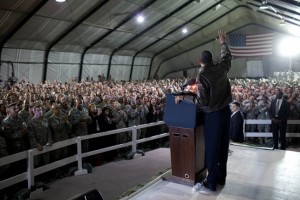
President Obama addresses U.S. troops at the Bagram base in Afghanistan on March 28, 2010. (White House photo by Pete Souza )
As the Afghan War grinds toward another U.S. military defeat -- on the heels of the forced departure from Iraq -- Official Washington remains in denial about these failed neocon strategies, still preferring to embrace happy myths about "successful surges" and ignoring the actual outcomes.
I encountered this cognitive dissonance again Saturday morning when I was flipping the TV channels and landed on MSNBC's "Up with Chris Hayes," with substitute host, the Washington Post's Ezra Klein. There was a panel of bright and attractive pundits again praising President George W. Bush's Iraq War "surge."
One had to wonder: Did these seemingly smart people not notice that the U.S. military was sent packing from Iraq at the end of 2011, less than three months ago? Do they not know that the giant U.S. Embassy, once meant to be a command center for imperial domination of the Middle East, sits mostly idle?
Were they oblivious to the fact that Iraq, still a shattered society afflicted by terrible sectarian violence, leans closer to Iranian foreign policy than America's because of Bush's invasion?
No doubt, the myth about Bush's "successful surge" has been deeply implanted in the conventional wisdom of Washington. But the truth is that it was only "successful" in that it delayed the ultimate American defeat until Bush and his neocon cohorts had vacated the White House and the blame could be shifted to President Barack Obama.
Other than sparing "war president" Bush the humiliation of having to admit defeat, the dispatching of 30,000 additional U.S. troops in early 2007 did little more than get nearly 1,000 additional Americans killed -- almost one-quarter of the war's total U.S. deaths -- along with what certainly was a much higher number of Iraqis.
For example, WikiLeaks's "Collateral Murder" video depicted one fairly typical scene during the "surge" in which U.S. firepower mowed down a group of Iraqi men, including two Reuters news staffers, walking down a street in Baghdad. The attack helicopters then wounded two children in a van which stopped to take survivors to a hospital.
Why the "Success'?
A more serious analysis of what happened in Iraq in 2007-08 would trace the decline in Iraqi sectarian violence mostly to strategies that predated the "surge" and were implemented by the commanding generals in 2006, George Casey and John Abizaid, who wanted as small a U.S. "footprint" as possible, to tamp down Iraqi nationalism.
Among their initiatives, Casey and Abizaid deployed a highly classified operation to eliminate key al-Qaeda leaders, most notably the killing of Abu Musab al-Zarqawi in June 2006. Casey and Abizaid also exploited growing Sunni animosities toward al-Qaeda extremists by paying off Sunni militants to join the so-called "Awakening" in Anbar Province.
And, as the Sunni-Shiite sectarian killings reached horrendous levels in 2006, the U.S. military assisted in the de facto ethnic cleansing of mixed neighborhoods by helping Sunnis and Shiites move into separate enclaves, thus making the targeting of ethnic enemies more difficult. In other words, the flames of violence were likely to have abated whether Bush ordered the "surge" or not.
Radical Shiite leader Moktada al-Sadr also helped by issuing a unilateral cease-fire, reportedly at the urging of his patrons in Iran who were interested in cooling down regional tensions and speeding up the U.S. withdrawal. By 2008, another factor in the declining violence was the growing awareness among Iraqis that the U.S. military's occupation indeed was coming to an end. Prime Minister Nouri al-Maliki insisted on -- and got -- a firm timetable for American withdrawal from Bush.
Even author Bob Woodward, who had published best-sellers that fawned over Bush's early war judgments, concluded that the "surge" was only one factor and possibly not even a major one in the declining violence.
In his book, The War Within, Woodward wrote, "In Washington, conventional wisdom translated these events into a simple view: The surge had worked. But the full story was more complicated. At least three other factors were as important as, or even more important than, the surge."
Woodward, whose book drew heavily from Pentagon insiders, listed the Sunni rejection of al-Qaeda extremists in Anbar province and the surprise decision of al-Sadr to order a cease-fire as two important factors. A third factor, which Woodward argued may have been the most significant, was the use of new highly classified U.S. intelligence tactics that allowed for rapid targeting and killing of insurgent leaders.
(Note: You can view every article as one long page if you sign up as an Advocate Member, or higher).





